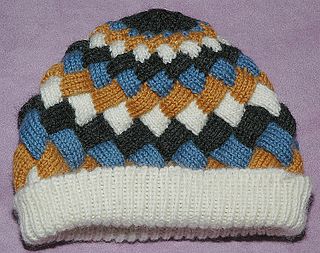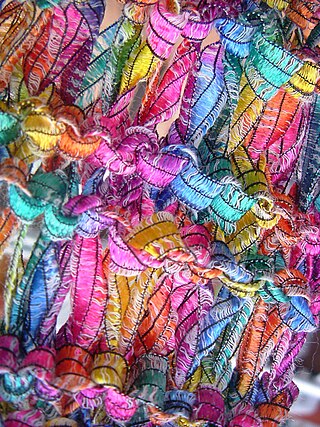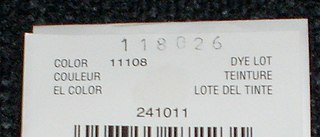
Crochet is a process of creating textiles by using a crochet hook to interlock loops of yarn, thread, or strands of other materials. The name is derived from the French term crochet, meaning 'hook'. Hooks can be made from a variety of materials, such as metal, wood, bamboo, or plastic. The key difference between crochet and knitting, beyond the implements used for their production, is that each stitch in crochet is completed before the next one is begun, while knitting keeps many stitches open at a time. Some variant forms of crochet, such as Tunisian crochet and broomstick lace, do keep multiple crochet stitches open at a time.

Knitting is a method for production of textile fabrics by interlacing yarn loops with loops of the same or other yarns. It is used to create many types of garments. Knitting may be done by hand or by machine.

Tatting is a technique for handcrafting a particularly durable lace from a series of knots and loops. Tatting can be used to make lace edging as well as doilies, collars, accessories such as earrings and necklaces, and other decorative pieces. The lace is formed by a pattern of rings and chains formed from a series of cow hitch or half-hitch knots, called double stitches, over a core thread. Gaps can be left between the stitches to form picots, which are used for practical construction as well as decorative effect.

Yarn is a long continuous length of interlocked fibres, used in sewing, crocheting, knitting, weaving, embroidery, ropemaking, and the production of textiles. Thread is a type of yarn intended for sewing by hand or machine. Modern manufactured sewing threads may be finished with wax or other lubricants to withstand the stresses involved in sewing. Embroidery threads are yarns specifically designed for needlework. Yarn can be made of a number of natural or synthetic materials, and comes in a variety of colors and thicknesses. Although yarn may be dyed different colours, most yarns are solid coloured with a uniform hue.

Nålebinding is a fabric creation technique predating both knitting and crochet. Also known in English as "knotless netting", "knotless knitting", or "single-needle knitting", the technique is distinct from crochet in that it involves passing the full length of the working thread through each loop, unlike crochet where the work is formed only of loops, never involving the free end. It also differs from knitting in that lengths must be pieced together during the process of nålebinding, rather than a continuous strand of yarn that can easily be pulled out. Archaeological specimens of fabric made by nålebinding can be difficult to distinguish from knitted fabric.

In the textile industry, a hank is a coiled or wrapped unit of yarn or twine, as opposed to other materials like thread or rope, as well as other forms such as ball, cone, bobbin spool, etc. This is often the best form for use with hand looms, compared to the cone form needed for power looms. Hanks come in varying lengths depending on the type of material and the manufacturer. For instance, a hank of linen is often 300 yards (270 m), and a hank of cotton or silk is 840 yards (770 m).

Entrelac is a knitting technique used to create a textured diamond pattern. While the result resembles basket-woven strips of knitted fabric, the actual material comprises interconnected squares on two different orientations.

Amigurumi is the Japanese art of knitting or crocheting small, stuffed yarn creatures. The word is a compound of the Japanese words 編み ami, meaning "crocheted or knitted", and 包み kurumi, literally "wrapping", as in 縫い包み nuigurumi "(sewn) stuffed doll". Amigurumi vary in size and there are no restrictions about size or look. While the art of amigurumi has been known in Japan for several decades, the craft first started appealing to the masses in other countries, especially in the West, in 2003. By 2006, amigurumi were reported to be some of the most popular items on Etsy, an online craft marketplace, where they typically sold for $10 to $100.

Drop-stitch knitting is a knitting technique for producing open, vertical stripes in a garment. The basic idea is to knit a solid fabric, then (deliberately) drop one or more stitches, producing a run in the fabric. The run will continue to the bottom edge of the garment, or until it encounters an increase, at which it stops.

Novelty yarns include a wide variety of yarns made with unusual features, structure or fiber composition such as slubs, inclusions, metallic or synthetic fibers, laddering and varying thickness introduced during production. Some linens, wools to be woven into tweed, and the uneven filaments of some types of silk are allowed to retain their normal irregularities, producing the characteristic uneven surface of the finished fabric. Man-made fibres, which can be modified during production, are especially adaptable for special effects such as crimping and texturizing.
Knitting clubs are a feature of the 21st-century revival of hand knitting which began in America and has spread to most of Europe. Despite the name, knitting clubs are not limited to knitting; both crochet-centered and knit-centered clubs are collectively called "knitting clubs." While knitting has never gone away completely, this latest reincarnation is less about the make-do and mend of the 1940s and 1950s, and more about making a statement about individuality and developing a sense of community.

A dye lot is a record taken during the dyeing of yarn to identify yarn that received its coloration in the same vat at the same time. Yarn manufacturers assign each lot a unique identification number and stamp it on the label before shipping. Slight differences in temperature, dyeing time, and other factors can result in different shades of the same color between different dye lots of otherwise identical production. Although the component elements of a dye lot number are of interest only for internal business recordkeeping, retail yarn consumers have an interest in ensuring that they purchase a given color of yarn from identical dye lots.
Hand knitting is a form of knitting, in which the knitted fabric is produced by hand using needles.

Variegated yarn is yarn dyed with more than one colour.

Yarn bombing is a type of graffiti or street art that employs colourful displays of knitted or crocheted yarn or fibre rather than paint or chalk. It is also called wool bombing, yarn storming, guerrilla knitting, kniffiti, urban knitting, or graffiti knitting.

Lion Brand Yarns, also known as Lion Brand Yarn Company and Lion Brand Yarn, was founded in 1878 in the United States. It is the oldest producer of knitting and craft yarn in the United States, and also publishes several knitting and crochet newsletters.

In the textile arts, a stitch is a single turn or loop of thread, or yarn. Stitches are the fundamental elements of sewing, knitting, embroidery, crochet, and needle lace-making, whether by hand or machine. A variety of stitches, each with one or more names, are used for specific purposes.

Tapestry crochet is sometimes called jacquard crochet, intarsia, mosaic, fair isle, and colorwork, but today these terms usually describe different techniques. Since the yarns are switched back and forth to create motifs, tapestry crochet fabric looks more like it was woven on a loom than crocheted with a hook.
















